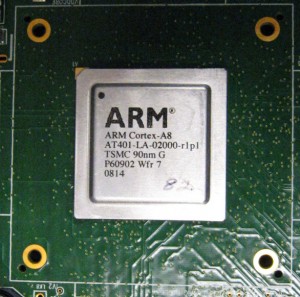In the following months, the mobilephere will be overtaken with several new devices and most of them will be running the same underlying chipset design. As any mobile power user will tell you, support for HD video and hardware-accelerated graphics are must-haves for future devices. What will most of these devices have in common? Several things actually. Nearly all will be based on the ARM Cortex A8 chipset, which means they are running the same basic chip with manufacturer-decided variations and branding schemes.
What is most exciting about this chipset is that HD video and hardware-accelerated graphics are now a reality for everybody. As a bonus, this chipset design also meets the ‘required specs‘ that Windows Mobile 7 purportedly has. These specs include-
| Core requirements: Processor: ARM v6+, L2 Cache, VFP, Open GL ES 2.0 graphics HW (QCOM 8k, Nvidia AP15/16* and TI 3430 all meet spec) Memory: 256MB+ DRAM, 1G+ Flash (at least 512MB fast flash – 5MB/s unbuffered read @4K block size) Display: WVGA (800×480) or FWVGA (854×480) 3.5” or greater diagonal Touch: Multi-touch required Battery: Sufficient to meet Days of Use LTK requirements. Controls: Start, Back, Send and End are required (soft controls allowed as long as they are always present). |
Following is a list of each ‘branded ARM A8 processor’ and their specifications. I have also listed an example device known to run that chip (is possible).
Make sure to check out this excellent explanation on the differences between the previous generation ARM 11 chipset and the new ARM Cortex A8 chipset if you want to get dirty with the details of why this is such an advancement in technology.
TEGRA
The Tegra chipset, manufactured by Nvidia, is to support
Key features:
|
Known Device- Zune HD
SNAPDRAGON
The Snapdragon chipset, designed by Qualcomm, has the following features-
|
Known devices-
Windows Mobile- Acer neoTouch S200 F1, HTC HD2, Toshiba TG01, LG Monaco,
Android- Acer Liquid A1, HTC Dragon, Sony Xperia X3
ARMADA
The Armada chipset, made by Marvell, includes the following features-
|
TI (the company, not the rapper) will be releasing their OMAP chipset, which will include-
| All of the devices feature hardware 2D/3D graphics acceleration except for the OMAP3610, OMAP3630/OMAP3640 are capable of 720p HD video playback, according to TI.Ti says all of the OMAP36xx SoCs offer support for XGA displays up to 1024 x 768 pixels, or WXGA displays up to 1280 x 800, and provide composite and S-Video TV output too. The devices include three high-speed USB 2.0 interfaces and one USB 2.0 On-The-Go interface, the company adds. |
As you can tell, there are quite a few names to describe the same basic feature set. All and all, it looks to be quite an exciting time for phone launches. With Windows Mobile 7 set to be released sometime later this year, expect a bevy of devices with the ARM A8 chipset to be announced and launched. Already we have seen leaks of a possible HTC HD3 and the HTC Oboe, and more are sure to come!
Sources of information-
Nvidia Tegra Info- Nvidia.com
Qualcomm Snapdragon Info- Qualcomm.com
Marvell Armada Info- Marvell.com
TI OMAP Info- LinuxFordDevices.com

